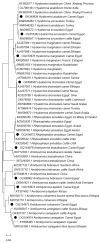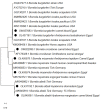The Surveillance of Borrelia Species in Camelus dromedarius and Associated Ticks: The First Detection of Borrelia miyamotoi in Egypt
- PMID: 36851446
- PMCID: PMC9961693
- DOI: 10.3390/vetsci10020141
The Surveillance of Borrelia Species in Camelus dromedarius and Associated Ticks: The First Detection of Borrelia miyamotoi in Egypt
Abstract
Tick-borne diseases (TBDs) are emerging and re-emerging infections that have a worldwide impact on human and animal health. Lyme borreliosis (LB) is a severe zoonotic disease caused by the spirochete Borrelia burgdorferi sensu lato (s.l.) transmitted to humans by the bite of infected Ixodes ticks. Borrelia miyamotoi is a spirochete that causes relapsing fever (RF) and is genetically related to Borrelia burgdorferi s.l. However, there have been no reports of B. miyamotoi in Egypt, and the data on LB in camels is scarce. Thus, the present study was conducted to screen and genetically identify Borrelia spp. and B. miyamotoi in Egyptian camels and associated ticks using polymerase chain reaction (PCR).
Methods: A total of 133 blood samples and 1596 adult hard ticks were collected from Camelus dromedaries at Cairo and Giza slaughterhouses in Egypt. Tick species were identified by examining their morphology and sequencing the cytochrome C oxidase subunit 1 (cox1) gene. Borrelia spp. was detected using nested PCR on the IGS (16S-23S) gene, and positive samples were genotyped using 16S rRNA and glpQ spp. genes specific for Borrelia burgdorferi and Borrelia miyamotoi, respectively. The positive PCR products were sequenced and analyzed by phylogenetic tree.
Results: Analysis of the cox1 gene sequence revealed that the adult ticks belonged to three genera; Hyalomma (H), Amblyomma (Am), and Rhipicephalus (R), as well as 12 species, including H. dromedarii, H. marginatum, H. excavatum, H. anatolicum, R. annulatus, R. pulchellus, Am. testudinarium, Am. hebraeum, Am. lipidium, Am. variegatum, Am. cohaerens and Am. gemma. Borrelia spp. was found in 8.3% (11/133) of the camel blood samples and 1.3% (21/1596) of the ticks, respectively. Sequencing of the IGS (16S-23S) gene found that B. afzelii, detected from H. dromedarii and H. marginatum, and B. crocidurae, which belongs to the RF group, was detected from one blood sample. B. burgdorferi and B. miyamotoi were discovered in the blood samples and tick species. Phylogenetic analysis of the glpQ gene showed that the B. miyamotoi in this study was of the Asian and European types.
Conclusions: These results suggest that the camels can be infected by Lyme borrelia and other Borrelia bacteria species. This study also provides the first insight into the presence of Borrelia miyamotoi and B. afzelii DNA in camels and associated ticks in Egypt.
Keywords: 16S-23S rRNA; Borrelia burgdorferi; Borrelia miyamotoi; camels; glpQ.
Conflict of interest statement
The authors declare that they have no competing interest.
Figures




Similar articles
-
Molecular detection of some zoonotic tick-borne pathogens in ticks collected from camels (Camelus dromedarius) as hosts and wild rodents as potential reservoirs.Vet Res Commun. 2024 Oct;48(5):3197-3207. doi: 10.1007/s11259-024-10488-9. Epub 2024 Aug 15. Vet Res Commun. 2024. PMID: 39145855 Free PMC article.
-
Evidence of the presence of Borrelia burgdorferi in dogs and associated ticks in Egypt.BMC Vet Res. 2021 Jan 25;17(1):49. doi: 10.1186/s12917-020-02733-5. BMC Vet Res. 2021. PMID: 33494772 Free PMC article.
-
Borrelia miyamotoi and Borrelia burgdorferi (sensu lato) identification and survey of tick-borne encephalitis virus in ticks from north-eastern Germany.Parasit Vectors. 2020 Feb 27;13(1):106. doi: 10.1186/s13071-020-3969-7. Parasit Vectors. 2020. PMID: 32106890 Free PMC article.
-
[Borrelia miyamotoi: a recently identified human pathogenic tick-borne relapsing fever spirochete].Orv Hetil. 2017 Jul;158(29):1124-1130. doi: 10.1556/650.2017.30791. Orv Hetil. 2017. PMID: 28714333 Review. Hungarian.
-
Borrelia miyamotoi-An Emerging Human Tick-Borne Pathogen in Europe.Microorganisms. 2021 Jan 12;9(1):154. doi: 10.3390/microorganisms9010154. Microorganisms. 2021. PMID: 33445492 Free PMC article. Review.
Cited by
-
Molecular detection of some zoonotic tick-borne pathogens in ticks collected from camels (Camelus dromedarius) as hosts and wild rodents as potential reservoirs.Vet Res Commun. 2024 Oct;48(5):3197-3207. doi: 10.1007/s11259-024-10488-9. Epub 2024 Aug 15. Vet Res Commun. 2024. PMID: 39145855 Free PMC article.
-
Screening Marine Microbial Metabolites as Promising Inhibitors of Borrelia garinii: A Structural Docking Approach towards Developing Novel Lyme Disease Treatment.Biomed Res Int. 2024 Feb 29;2024:9997082. doi: 10.1155/2024/9997082. eCollection 2024. Biomed Res Int. 2024. PMID: 38456098 Free PMC article.
-
Prevalence of Lyme Disease and Relapsing Fever Borrelia spp. in Vectors, Animals, and Humans within a One Health Approach in Mediterranean Countries.Pathogens. 2024 Jun 17;13(6):512. doi: 10.3390/pathogens13060512. Pathogens. 2024. PMID: 38921809 Free PMC article. Review.
-
Evaluation of three mitochondrial DNA markers for species identification, genetic diversity assessment, and phylogenetic positioning of five Hyalomma tick species from Tunisia.Exp Appl Acarol. 2024 Dec 30;94(1):21. doi: 10.1007/s10493-024-00985-6. Exp Appl Acarol. 2024. PMID: 39738936
-
Molecular detection of Coxiella burnetii in blood and hard tick-infested Egyptian camels and the possibility of coinfections.Trop Anim Health Prod. 2024 Oct 10;56(8):335. doi: 10.1007/s11250-024-04131-7. Trop Anim Health Prod. 2024. PMID: 39384660 Free PMC article.
References
-
- Qamar M., Ayaz M., Nazir M. Isolation and identification of ectoparasites in single humped camels (Camelus dromedarius) of Cholistan area, Pakistan. Iraqi J. Vet. Sci. 2019;32:291–297. doi: 10.33899/ijvs.2019.153866. - DOI
-
- Bellabidi M., Benaissa M.H., Bissati-Bouafia S., Harrat Z., Brahmi K., Kernif T. Coxiella burnetii in camels (Camelus dromedarius) from Algeria: Seroprevalence, molecular characterization, and ticks (Acari: Ixodidae) vectors. Acta Trop. 2020;206:105443. doi: 10.1016/j.actatropica.2020.105443. - DOI - PubMed
LinkOut - more resources
Full Text Sources
Miscellaneous

